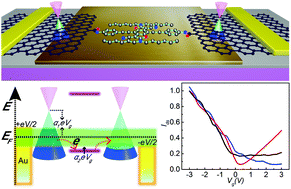Dirac-cone induced gating enhancement in single-molecule field-effect transistors†
Abstract
Using graphene as electrodes provides an opportunity for fabricating stable single-molecule field-effect transistors (FETs) operating at room temperature. However, the role of the unique graphene band structure in charge transport of single-molecule devices is still not clear. Here we report the Dirac-cone induced electrostatic gating effects in single-molecule FETs with graphene electrodes and a solid-state local bottom gate. With the highest occupied molecular orbital (HOMO) as the dominating conduction channel and the graphene leads remaining intrinsic at zero gate voltage, electrostatic gating on the HOMO and the density of states of graphene at the negative gate polarity reinforces each other, resulting in an enhanced conductance modulation. In contrast, gating effects on the HOMO and the graphene states at the positive gate polarity are opposite. Depending on the gating efficiencies, the conductance can decrease, increase or remain almost unchanged when a more positive gate voltage is applied. Our observations can be well understood by a modified single-level model taking into account the linear dispersion of graphene near the Dirac point. Single-molecule FETs with Dirac-cone enhanced gating have shown high performances, with the modulation of a wide range of current over one order of magnitude. Our studies highlight the advantages of using graphene as an electrode material for molecular devices and pave the way for single-molecule FETs toward circuitry applications.



 Please wait while we load your content...
Please wait while we load your content...